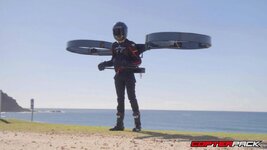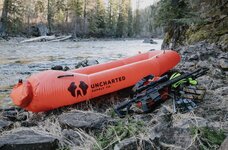I'm guessing this isn't the most poplar thing to do but what are people using to cross water that's knee deep or so. Do you just take off you shoes and go or is there anything people carry when they think this is going to have to be done? Specifically for late season.
You are using an out of date browser. It may not display this or other websites correctly.
You should upgrade or use an alternative browser.
You should upgrade or use an alternative browser.
Crossing rivers and streams
- Thread starter jaym_100
- Start date
I'm guessing this isn't the most poplar thing to do but what are people using to cross water that's knee deep or so. Do you just take off you shoes and go or is there anything people carry when they think this is going to have to be done? Specifically for late season.
If plan A involves crossing knee-deep moving water with gear (and an animal) in the late season, you need to invest some time in plan B.
trophyhill
WKR
Last time I did this, I put my chest waders on and threw my boots over my shoulder and changed back into them on the other side. On my way back across the snow had melted some during the day, and it was like a raging river nearly chest high. The trekking poles were a lifesaver. Literally. Not to mention the rushing water was hypnotizing and dizzying.
I recently purchased some T&K gaiters for the situation you described.
I recently purchased some T&K gaiters for the situation you described.
westslopelaker
Lil-Rokslider
We always just take boots, socks, and pants off for the crossing. It's chilly but once you start moving again you'll warm right up. The place we cross is miles from a truck so it's not really feasible to bring waders and it's too wide to rock hop.
Mike Islander
WKR
Shallow stream with slow moving water, I'm happy to take off my boots in any temperature if it looks like they might go under enough to get wet inside. Fast, deep, during cold weather = NOPE. I'm solo 99% of the time. Limiting risk is way up on my priorities list. How high up? Scouting for bear in the upstate meant crossing a river and sleeping on the other side. Started to rain pretty good, despite the forecast. Though I'd driven almost 5 hours to get there and hiked another 2, I turned around, hiked back, and drove home. Not going to cross a river in high water, so that was that. Should have planned to put my car on the other side even if it meant a longer hike, even though they said it wasn't going to rain.
- Thread Starter
- #6
The reason I ask, this was my first elk hunt. First western hunt in general and there were tons of people. The stream was super slow and might have been to my knees. I was with a group and it wasn't going to happen but that probably would have been a good way to get away from a lot of other hunters. Trying to keep the spot in mind if I come back there next year. I have done some fly fishing and know how slippery rocks get, so also wondering because of that.
IBen
WKR
- Joined
- May 15, 2021
- Messages
- 353
Carry a pair of trail runners and use them to cross. As someone who has made damn near a thousand river crossings in alaska in the last 3 years i would absolutely not recommend trekking poles at all. You have to keep your balance and let the river move you. You cannot fight the river. There are a few techniques you can use. I like to face up river, pick my exit spot about 30 yards downstream and keep a strong back foot. Rifle in hand. If its higher than belly button you will be bouncing
IBen
WKR
- Joined
- May 15, 2021
- Messages
- 353
Also if you are in a really treacherous crossing do not use waders. They create way too much drag and could kill you if they fill up from the top.
They make lightweight waders just for this.
Google it and you will get some ideas.
I have done it in the past but where I live and hunt now I don't have that need. I do not remember the brand I used back then, but they are out there and are way lighter and more packable than regular waders.
I have also used contracter trash bags on smaller crossings.
Google it and you will get some ideas.
I have done it in the past but where I live and hunt now I don't have that need. I do not remember the brand I used back then, but they are out there and are way lighter and more packable than regular waders.
I have also used contracter trash bags on smaller crossings.
Last edited:
GSPHUNTER
WKR
- Joined
- Jun 30, 2020
- Messages
- 4,534
If it's knee deep fast water, find a way around it. If it's wide and slow I just put on water shoes and go for it.
RS_Non-Res
WKR
- Joined
- May 1, 2021
- Messages
- 478
Look upstream a ways and see if there's a tree/bridge(?)
mtnbiker208
WKR
wigglys waders
Yup, that's the one!wigglys waders
TY
TaperPin
WKR
- Joined
- Jul 12, 2023
- Messages
- 3,230
I sew up something similar to wigglys waders that go over your boots. Just stash them if you come back the same way. Extra wading boots or shoes can also be a good idea. Dont throw away worn out boots if they can be used for a crossing and stashed for the return.
I would never cross in bare feet - a great way to have an injury end your hunt. If nothing else take your socks off, cross and use gortex socks over your normal socks to help keep your feet somewhat dry.
If you aren’t used to mountain rain raising the stream levels, it can get you - almost flash floodish. Knee deep water becomes waist deep fast water and you have to cross to get to the trailhead. If you don’t fly fish or have other reasons to wade in streams, get used to it before a hunt. Unbuckle your pack in case you go for a swim so it doesn’t take you with it. Point upstream, and shuffle your feet on the bottom so the current can‘t push them as much. I like one freaking pole for fast water. It can help to hold onto your buddy as you work across, but not always. I like my rifle attached to the pack in case we go for a swim, it’s easier to find things if they are all together. Find a spot with a consistent current and stay away from big rocks - behind the rock can be a break from the current, but water speed can be much worse on the sides.
It’s a sick feeling when you have to cross deeper and faster water than you’re comfortable with - have a plan if you go for a swim - you can’t just shed your pack and watch it float away - getting that pack should happen quick. Don’t cross upstream of a bad spot. Don’t step on top of slick rocks, but step down where your feet cant slip. Be extra careful of sketchy crossings on partially submerged trees - slip off the wrong side and water currents will try to suck you under the log.
I would never cross in bare feet - a great way to have an injury end your hunt. If nothing else take your socks off, cross and use gortex socks over your normal socks to help keep your feet somewhat dry.
If you aren’t used to mountain rain raising the stream levels, it can get you - almost flash floodish. Knee deep water becomes waist deep fast water and you have to cross to get to the trailhead. If you don’t fly fish or have other reasons to wade in streams, get used to it before a hunt. Unbuckle your pack in case you go for a swim so it doesn’t take you with it. Point upstream, and shuffle your feet on the bottom so the current can‘t push them as much. I like one freaking pole for fast water. It can help to hold onto your buddy as you work across, but not always. I like my rifle attached to the pack in case we go for a swim, it’s easier to find things if they are all together. Find a spot with a consistent current and stay away from big rocks - behind the rock can be a break from the current, but water speed can be much worse on the sides.
It’s a sick feeling when you have to cross deeper and faster water than you’re comfortable with - have a plan if you go for a swim - you can’t just shed your pack and watch it float away - getting that pack should happen quick. Don’t cross upstream of a bad spot. Don’t step on top of slick rocks, but step down where your feet cant slip. Be extra careful of sketchy crossings on partially submerged trees - slip off the wrong side and water currents will try to suck you under the log.
GunsAreFun
WKR
- Joined
- Apr 18, 2019
- Messages
- 1,739
Ha! On it
Since I was tagged on this thread, here’s a pair of DIY waders I made about 9-10 years ago.
Similar threads
- Replies
- 77
- Views
- 3K
Featured Video
Stats
Latest Articles
-
WE WON!
-
Mule Deer Rut Update & Buck Story
-
Sitka Gear HyperDown Sleeping Bag Review
-
TT#42 Mark Denham with Outdoorsmans history and innovations.
-
Kryptek Traverse Merino Review
-
First Lite 308 Pant Review
-
Argali Selway 6P Tent Review
-
AGC Kobuk 2800 Backpack Review
-
Hunting The Leaf-off Window
-
TT#41 Jordan Budd’s Tips on Finding and Killing the Big One


